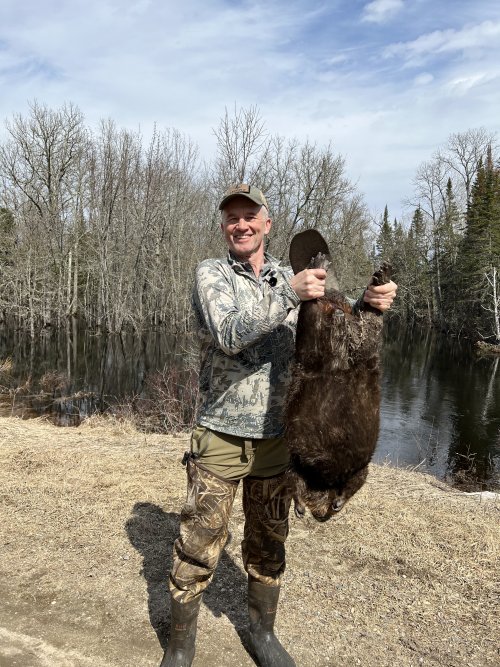I'm on my way to the airport following a week of filming my buddies doing their spring "beaver control." Spring beaver trapping was one of the strongest traditions in Northern Minnesota when I grew up here, now just a quickly fading passion among the gray-haired crowd who does it for fun.
Two high school buddies, Wally and Dick previously trapped 200+ beaver a season when prices were higher and costs were lower. I told them I wanted to come back and film spring beaver trapping, but I would need to talk them out of retirement in order to do so. Minnesota does not allow non-residents to trap, so I couldn't trap, only film. They agreed.
We set the middle of April as our target date of open water and traveling beaver aplenty. The cold winter and late spring 2022 conditions of the northern latitudes kept the waters ice-covered later than normal, so Dick called and suggest we try the last week of April. With a new date set, I showed up last weekend, spent some time with Mom, then we headed north for the first check of the week on Monday afternoon.
Dick and Wally saw the forecast of snow and cold on Monday and Tuesday, and knowing how that slows beaver movement, they went out on Sunday afternoon and set 24 traps in hopes we could get an extra day of checking the line during my five days. That was a good idea, as Monday was cold, windy, and spitting snow. A one-inch layer of ice had formed and given temps on Monday night were to be 15F, more ice would form that night.
Monday afternoon we headed out to places where flooded creeks, rivers, and ditches crossed the old roads and highways. A good run ended up with 11 beaver in 24 traps. That's a great catch rate given the conditions.
Tuesday was not expected to be much, as the cold had froze most the sets. The only hope was that beaver might have moved before the ice layers formed that night. Lucked out and eight more beaver found the sets. Brother Jason joined us that day, which added some great laughs and some ribbing of his older brother.
Wednesday was a better day, with temps warming overnight, which is great for beaver movement. The guys ended up with 12, including about half of them being big old adults. With prices being so low, nobody is trapping, so the mix of old beaver is much higher than expected. Jason, Shawn (mayor) and his son, Logan, joined us. Too many old stories being told, some of which represented a younger behavior that would surely ruin any chance of me continuing these platforms if such behavior had been recorded on a cell phone camera.
Thursday brought big expectations, knowing a warm day and night like Wednesday would trigger a lot more beaver movement. By day's end, 13 beaver were in the back of the truck. The flood-stage water levels were dropping fast, so anticipating where to set the trap had been a challenge. Set it too deep and the beaver swims right over it. Set it too shallow and the trap is high and dry when the levels drop 10" overnight.
I had to leave Friday afternoon, so Friday morning was the last check. Not bad for the few remaining sets they had out. Ended up with nine more beaver. That brought the total for five checks over four and a half days to 53 beaver.
I wasn't allowed to help with the trapping, but I got to tune up my skinning skills. We skinned, fleshed, and stretched eleven of the largest unbitten beaver with the darkest fur. I will get those tanned and get garments made of them.
The rest will be sold to one of the three buyers who purchase "round beaver." The term "round beaver" means beaver as the entire carcass. These round buyers will utilize the fur, mostly for the hat market. They will extract the castors, the most valuable part of the beaver. The final step is to sell the tails to specialty leather crafters and sell the carcasses to places that can use them for pet foods and other rendered uses. When it is all done, every part of the beaver is used. That is what allows the buyer to pay $12-13 "per tail." By "per tail," it explains that they just count the tails and pay that set amount, without any measurement of sizes or fur condition.
Northern Minnesota is mostly one big swamp, transected by a large number of rivers that drain to the north, dumping into the Rainy River, then to Lake of The Woods, then to Lake Winnipeg, where the Nelson River takes it all to Hudson's Bay, where the Hudson's Bay Company (HBC) established Fort Nelson in 1684 and later York Factory to take advantaged of the indigenous people wanting to trade beaver plews for goods otherwise not available to them. This trading market stayed in place for over 150 years, until silk took over beaver felt and fur as the hat fashion in Europe.
These indigenous communities were the supply chain for the fur trade. The Hudson's Bay Company, and later the Northwest Fur Company, did not do the trapping. They were merely traders of "furs for goods." This is different from the later phase American Fur Company, where J.J. Astor sent out a cadre of "free trappers," a/k/a mountain men, to trap the western states. For hundreds of years prior, a sustainable harvest of beaver and other furs occurred in the Hudson's Bay drainage.
The HBC was the first corporation chartered in North America. It was granted franchise to all waters draining to Hudson's Bay. Look at a map and you see the immensity of that territory. This was a British enterprise that used the forts and ports around Hudson's Bay to gather furs and ship them to London where the hat business had an insatiable appetite for beaver.
In the later 1770's, the North West Fur Company, a French enterprise based out of Quebec City and Montreal, decided to challenge the HBC for fur trade in the Great Lakes areas. They formed teams of voyageurs to go up the St. Lawrence River and through the Great Lakes, trading the huge piles of goods they carried to the far reaches. They established the western-most Fort at Grand Portage on the north shore of Lake Superior, where a 8.5 mile portage would take them around the worst stretches of the Pigeon River, where canoes could then be used to explore the upper reaches of northern Minnesota. This was a much easier path for indigenous people to deliver their furs, making Grand Portage a key outpost, later moved to Fort William (Thunder Bay, Ontario) and eventually forcing a merger of HBC and the North West Company.
That's the history explaining how the most beaver-rich areas of North America, the Hudson's Bay drainage, never became void of beaver. Just too hard to navigate, too isolated, and not enough indigenous man power to exploit the vast resource to the degree the mountain beaver populations were exploited. Today's beaver numbers are robust, awaiting the next round of tularemia that will take out a majority of the population, then starting back on another up-cycle that follows these huge population declines. Our trapping is at the far southern headwaters of this drainage, very accessible by roads.
Wally is a supervisor for the County Road crews. The amount of beaver damage to roads is in the hundreds of thousands of dollars every year. He and his crews spend a lot of their summer time blasting and removing beaver dams that are damaging roads. He's so addicted to beaver trapping that he took this week of vacation to do more "beaver control." Dick has beaver regularly destroying his trees, so it's not hard to convince him to knock down the beaver population by applying his decades of trapping experience to the cause.
Beaver colonies consist of three generations of beaver. The older pair, their two year-old litter, and their on-year old litter. Every spring, the two year-olds get booted, forcing them to travel and look for their own mates and locations to colonize. High water also floods out a lot of houses and dens that are built just above the stable water line of fall/winter. These high waters of spring flood them out, putting dens and some lodges under water, forcing the adults to travel to new locations until water levels subside. The creeks and rivers are the travel corridors for these beaver at spring, so most of the sets were for these traveling beaver and only a few were set up on flowages to take the resident beaver.
Since I was the camera guy, the editors are going to have a hard task making anything worth watching. But, that is what they were stuck with, so we will see what kind of magic they produce. Hopefully it is something work watching.
A few photos of the last five days. Thanks so much to Dick and Wally for taking the time from their schedules to spend it trapping beaver with me. It reminded me how much trapping, especially beaver trapping, formed my strong connection to the wild world.
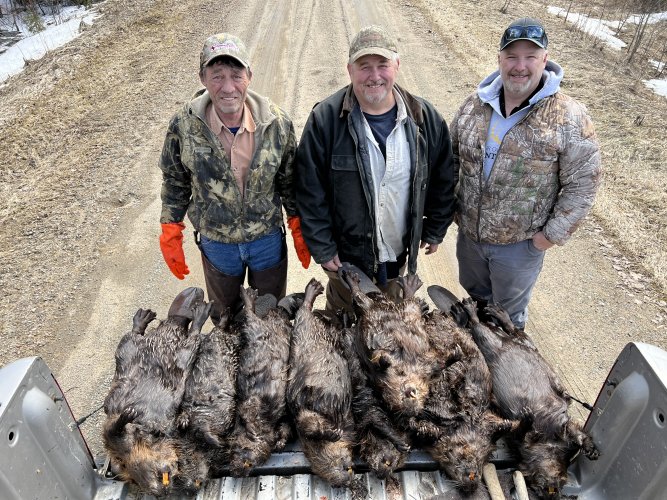
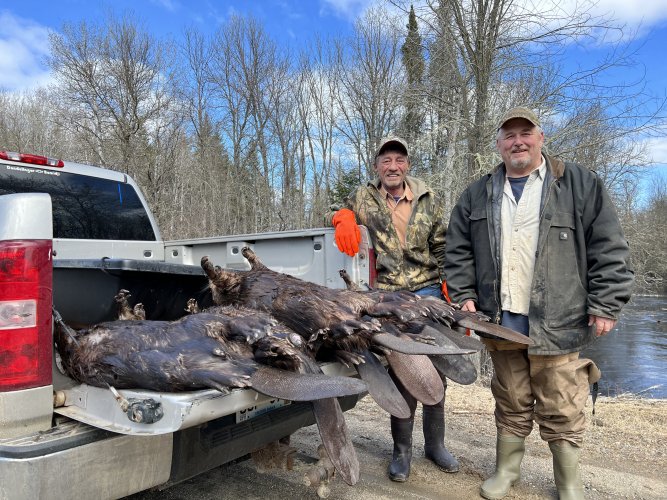
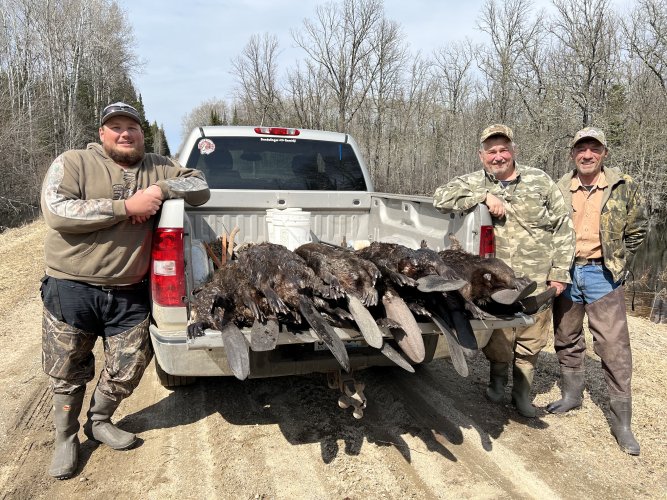
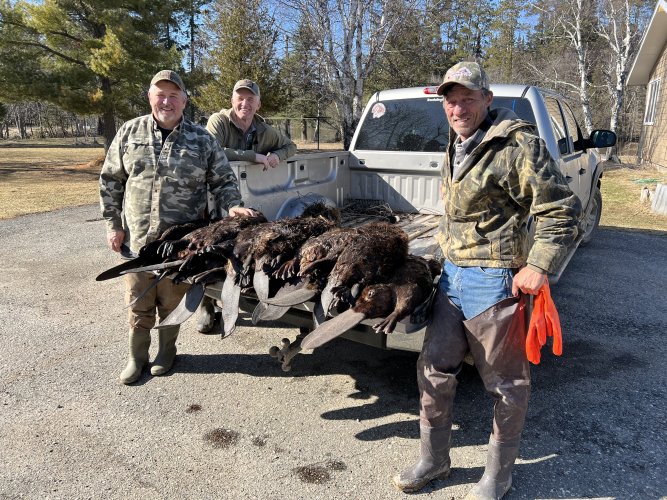
Two high school buddies, Wally and Dick previously trapped 200+ beaver a season when prices were higher and costs were lower. I told them I wanted to come back and film spring beaver trapping, but I would need to talk them out of retirement in order to do so. Minnesota does not allow non-residents to trap, so I couldn't trap, only film. They agreed.
We set the middle of April as our target date of open water and traveling beaver aplenty. The cold winter and late spring 2022 conditions of the northern latitudes kept the waters ice-covered later than normal, so Dick called and suggest we try the last week of April. With a new date set, I showed up last weekend, spent some time with Mom, then we headed north for the first check of the week on Monday afternoon.
Dick and Wally saw the forecast of snow and cold on Monday and Tuesday, and knowing how that slows beaver movement, they went out on Sunday afternoon and set 24 traps in hopes we could get an extra day of checking the line during my five days. That was a good idea, as Monday was cold, windy, and spitting snow. A one-inch layer of ice had formed and given temps on Monday night were to be 15F, more ice would form that night.
Monday afternoon we headed out to places where flooded creeks, rivers, and ditches crossed the old roads and highways. A good run ended up with 11 beaver in 24 traps. That's a great catch rate given the conditions.
Tuesday was not expected to be much, as the cold had froze most the sets. The only hope was that beaver might have moved before the ice layers formed that night. Lucked out and eight more beaver found the sets. Brother Jason joined us that day, which added some great laughs and some ribbing of his older brother.
Wednesday was a better day, with temps warming overnight, which is great for beaver movement. The guys ended up with 12, including about half of them being big old adults. With prices being so low, nobody is trapping, so the mix of old beaver is much higher than expected. Jason, Shawn (mayor) and his son, Logan, joined us. Too many old stories being told, some of which represented a younger behavior that would surely ruin any chance of me continuing these platforms if such behavior had been recorded on a cell phone camera.
Thursday brought big expectations, knowing a warm day and night like Wednesday would trigger a lot more beaver movement. By day's end, 13 beaver were in the back of the truck. The flood-stage water levels were dropping fast, so anticipating where to set the trap had been a challenge. Set it too deep and the beaver swims right over it. Set it too shallow and the trap is high and dry when the levels drop 10" overnight.
I had to leave Friday afternoon, so Friday morning was the last check. Not bad for the few remaining sets they had out. Ended up with nine more beaver. That brought the total for five checks over four and a half days to 53 beaver.
I wasn't allowed to help with the trapping, but I got to tune up my skinning skills. We skinned, fleshed, and stretched eleven of the largest unbitten beaver with the darkest fur. I will get those tanned and get garments made of them.
The rest will be sold to one of the three buyers who purchase "round beaver." The term "round beaver" means beaver as the entire carcass. These round buyers will utilize the fur, mostly for the hat market. They will extract the castors, the most valuable part of the beaver. The final step is to sell the tails to specialty leather crafters and sell the carcasses to places that can use them for pet foods and other rendered uses. When it is all done, every part of the beaver is used. That is what allows the buyer to pay $12-13 "per tail." By "per tail," it explains that they just count the tails and pay that set amount, without any measurement of sizes or fur condition.
Northern Minnesota is mostly one big swamp, transected by a large number of rivers that drain to the north, dumping into the Rainy River, then to Lake of The Woods, then to Lake Winnipeg, where the Nelson River takes it all to Hudson's Bay, where the Hudson's Bay Company (HBC) established Fort Nelson in 1684 and later York Factory to take advantaged of the indigenous people wanting to trade beaver plews for goods otherwise not available to them. This trading market stayed in place for over 150 years, until silk took over beaver felt and fur as the hat fashion in Europe.
These indigenous communities were the supply chain for the fur trade. The Hudson's Bay Company, and later the Northwest Fur Company, did not do the trapping. They were merely traders of "furs for goods." This is different from the later phase American Fur Company, where J.J. Astor sent out a cadre of "free trappers," a/k/a mountain men, to trap the western states. For hundreds of years prior, a sustainable harvest of beaver and other furs occurred in the Hudson's Bay drainage.
The HBC was the first corporation chartered in North America. It was granted franchise to all waters draining to Hudson's Bay. Look at a map and you see the immensity of that territory. This was a British enterprise that used the forts and ports around Hudson's Bay to gather furs and ship them to London where the hat business had an insatiable appetite for beaver.
In the later 1770's, the North West Fur Company, a French enterprise based out of Quebec City and Montreal, decided to challenge the HBC for fur trade in the Great Lakes areas. They formed teams of voyageurs to go up the St. Lawrence River and through the Great Lakes, trading the huge piles of goods they carried to the far reaches. They established the western-most Fort at Grand Portage on the north shore of Lake Superior, where a 8.5 mile portage would take them around the worst stretches of the Pigeon River, where canoes could then be used to explore the upper reaches of northern Minnesota. This was a much easier path for indigenous people to deliver their furs, making Grand Portage a key outpost, later moved to Fort William (Thunder Bay, Ontario) and eventually forcing a merger of HBC and the North West Company.
That's the history explaining how the most beaver-rich areas of North America, the Hudson's Bay drainage, never became void of beaver. Just too hard to navigate, too isolated, and not enough indigenous man power to exploit the vast resource to the degree the mountain beaver populations were exploited. Today's beaver numbers are robust, awaiting the next round of tularemia that will take out a majority of the population, then starting back on another up-cycle that follows these huge population declines. Our trapping is at the far southern headwaters of this drainage, very accessible by roads.
Wally is a supervisor for the County Road crews. The amount of beaver damage to roads is in the hundreds of thousands of dollars every year. He and his crews spend a lot of their summer time blasting and removing beaver dams that are damaging roads. He's so addicted to beaver trapping that he took this week of vacation to do more "beaver control." Dick has beaver regularly destroying his trees, so it's not hard to convince him to knock down the beaver population by applying his decades of trapping experience to the cause.
Beaver colonies consist of three generations of beaver. The older pair, their two year-old litter, and their on-year old litter. Every spring, the two year-olds get booted, forcing them to travel and look for their own mates and locations to colonize. High water also floods out a lot of houses and dens that are built just above the stable water line of fall/winter. These high waters of spring flood them out, putting dens and some lodges under water, forcing the adults to travel to new locations until water levels subside. The creeks and rivers are the travel corridors for these beaver at spring, so most of the sets were for these traveling beaver and only a few were set up on flowages to take the resident beaver.
Since I was the camera guy, the editors are going to have a hard task making anything worth watching. But, that is what they were stuck with, so we will see what kind of magic they produce. Hopefully it is something work watching.
A few photos of the last five days. Thanks so much to Dick and Wally for taking the time from their schedules to spend it trapping beaver with me. It reminded me how much trapping, especially beaver trapping, formed my strong connection to the wild world.








